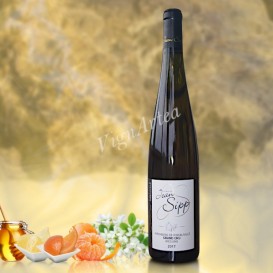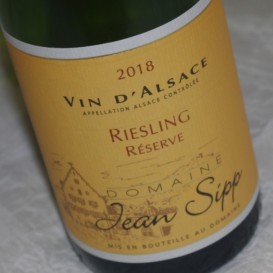Domaine Jean SIPP - Alsace

ALSACE 24 ha HVE 3 WINEMAKER: Jean-Guillaume SIPP
ESTATE HISTORY
Located in the heart of Ribeauvillé, the Jean SIPP estate works 24 hectares of vines spread over 50 plots scattered over 5 communes, including part of the terroirs classified as Grand Cru: Kirchberg de Ribeauvillé, Osterberg (Ribeauvillé) and Altenberg de Bergheim.
Among the plots classified as traditional Alsace designation, we find the unique CLOS RIBEAUPIERRE, a small vineyard of 1.5 ha, planted on the moutain side with slopes reaching up to 40%, and which is made famous by its history since these lands belonged, in the Middle Ages, to the lordly family of Ribeauvillé.
TERROIR
The varied landscapes of Alsace, where mountains, hills and plains rub shoulders, are due to the great diversity of the rocks making up the subsoil and which reliefs were shaped over 50 million years by the Rhine rift valley appearance.
Nearly a billion years ago, the succession of the marine and continental sedimentary deposits from the primary and secondary eras covered the old magmatic rocks base. At the end of the Jurassic period, the first signs of instability were seen in the form of an intense volcanic activity, with the emersion of the Rhine plateau, which will erode for 100 million years.
During the Tertiary era, distension and fractures led to the collapse of the Rhine block keystone with its sedimentary cover.
The Jean SIPP estate terroir lies on soil dating from the secondary era, more precisely from the Triassic (-245 to -199 My) and the Middle Jurassic (-175 to -161 My), mainly composed of marls, limestones and sandstones, which sedimentation took place in marine to brackish environments.
The Grand Cru Kirchberg de Ribeauvillé occupies a faulted compartment of the Triassic period where Voltzia sandstones, dolomitic sandstones & marls as well as sandstone marls follow one another from bottom to top. This type of stony, sandy and clayey soil is suitable for Riesling, Muscat and Gewürztraminer variety.
The Grand Cru Osterberg offers a subsoil compartmentalized by faults and which resembles the Grand Cru Kirchberg of Ribeauvillé's one, but with a dominant outcrop of sandstone and dolomitic marls.
As for the Grand Cru Altenberg de Bergheim, situated to the north of the Ribeauvillé fracture field, it rests on a subsoil composed of eight different terrains, ranging from Keuper clays (Upper Triassic) to Oligocene limestone conglomerates (-33 to -23 Ma), but the numerous faults juxtapose mainly Jurassic marls & limestones.
WINEGROWING & WINEMAKING
Since 2014, Jean-Guillaume SIPP has been managing the estate after having worked with the great names in the field: Zind-Humbrecht, Olivier Leflaive, Marcel Guigal, etc.
While waiting to obtain the organic farming label for the 2021 vintage, the estate has already been certified HVE 3 (High Environmental Value) since 2019, a certification that recognises farms committed to environmentally friendly approaches.
The grapes maturity is checked by tasting the berries before deciding on the harvest date. For the Grands Crus and wines bearing the 'Vieilles Vignes' and 'Vendanges Tardives' labels, two pickings are necessary and the harvest can last until mid-November.
White wines making
The grapes are picked by hand, by variety and by terroir. They are then pressed within two hours of the harvest by using a pneumatic press. The must is transferred to vats for a 24-hour static settling before being racked to vats or 50 hl tuns for the alcoholic and malolactic fermentations.
When the fermentations are over, the must is racked and filtered before bottling, except for the 'Grands Crus' and 'Vieilles Vignes' qualities which are aged in tuns for 8 to 11 months.
Red wines making
The Pinot Noir is entirely destemmed and then vatted for a 15 days to 3 weeks maceration period. The must is racked and then aged in French oak barrels for 12 months. At the end of the maturing process, the must is racked twice in succession to remove the lees and then bottled without filtration.
Renowned for the quality of its Grands Crus and their excellent Riesling wines, the Jean SIPP estate delights us with each vintage, when time for tasting has come. The winaes aromas are extremely complex, and the balance between the natural sweetness of the juice and its acidity is perfectly controlled. Great work.

-
RIESLING GRAND CRU KIRCHBERG 2017 (Domaine Jean Sipp)
29,99 € OUT OF STOCK!OUT OF STOCK!ALSACE - AOP ALSACE GRAND CRU - DRY WHITE WINE
Grape variety: Riesling (100%)
Lees ageing for 8 to 10 months in tunes
- Nose: discreet petroleum notes, aromas of mandarin, candied citrus and white flowers with a hint of honey.
- Palate: supple attack, beautiful juice, full and ample. The finish is marked by candied fruit.
Tasting date: October 2021
OUR OPINION: a Grand Cru of excellence that should be decanted 30 minutes before serving so that it can breathe.
-
PINOT BLANC LES TROIS TERROIRS 2019 (Domaine Jean Sipp)
9,95 € In stock!ALSACE - AOP ALSACE - WHITE WINE
Grape variety: Pinot Blanc (100%)
Lees ageing for 8 months in vats
Screw cap- Nose: floral and delicate. Scents of lily of the valley and lychee.
- Palate: supple, tasty and fresh attack.
Tasting date: October 2021
OUR OPINION: less exuberant than its predecessors, this vintage plays the card of discreet elegance and minerality.
-
PINOT NOIR 2017 - BARRIQUE (Domaine Jean Sipp)
19,50 € In stock!ALSACE - AOP ALSACE - RED WINE
Grape variety: Pinot Noir (100%)
Ageing in oak barrels for 12 months
- Nose: complex, spicy and liquorice. Notes of blackberry and blueberry aromas, with a hint of violet.
- Palate: round juice with a generous fruit.
Tasting date: October 2021.
OUR OPINION: unable to resist it!
-
OSMOSE 2017 (Domaine Jean Sipp)
40,70 € In stock!ALSACE - AOP ALSACE - RED WINE
Grape variety: Pinot Noir (100%)
Single-plot cuvée Destemming (100%)
Ageing in oak barrels for 12 months- Nose: Fine and tasty. The first notes are delicately vanilla and spicy, with aromas of blackberry, raspberry and roasted coffee.
- Palate: Fluid and juicy. Tannins of great finesse. Fruity finish.
Tasting date: October 2021
OUR OPINION: very nice Pinot Noir, elegant and delicately roasted.
-
CUVÉE CAROLE 2017 (Domaine Jean Sipp)
31,20 € In stock!ALSACE - AOP ALSACE - WHITE WINE
Grape variety: Gewürztraminer (100%)
Lees ageing for 6 months in tunes for 6 months
- Nose: intensely fragrant and generous. Aromas of rose, apricot, lychee with a hint of candied orange.
- Palate: nice sweetness on the palate counterbalanced by the natural acidity of the wine.
Tasting date: October 2021
OUR OPINION: extremely tasty!
-
RIESLING LIEU-DIT HAGUENAU 2017 (Domaine Jean Sipp)
21,50 € OUT OF STOCK!OUT OF STOCK!ALSACE - AOP ALSACE - DRY WHITE WINE
Grape variety: Riesling (100%)
Lees ageing in tunes for 8 months
- Nose: mineral. Notes of lemon and pink grapefruit with a hint of white peach.
- Palate: supple, dense, tasty and structured by a beautiful acidity with a finish on acacia honey notes.
Tasting date: October 2020.
OUR OPINION: a very complex and pleasant riesling.
-
RIESLING VIEILLES VIGNES 2016 (Domaine Jean Sipp)
15,50 € In stock!ALSACE - AOP ALSACE - DRY WHITE WINE
Grape variety: Riesling (100%)
Lees ageing in tunes for 10 months
- Nose: powerful and mineral. Aromas of lemon, pink grapefruit and currant.
- Palate: frank attack. tonic and nicely perfumed juice.
Tasting date: October 2020
OUR OPINION: very nice Riesling, ample and generous.
-
MUSCAT RÉSERVE 2019 (Domaine Jean Sipp)
13,99 € In stock!ALSACE - AOP ALSACE - WHITE WINE
Grape variety: Muscat (100%)
Process of converting to Organic
Lees ageing for 6 months in concrete tanks screw cap- Nose: floral. Intense aromas of lily of the valley, rose and lychee.
- Palate: soft and pleasantly scented.
Tasting date: October 2020
OUR OPINION: nice little muscat, fresh and tasty.
-
RIESLING RÉSERVE 2018 (Domaine Jean Sipp)
12,90 € In stock!ALSACE - AOP ALSACE - DRY WHITE WINE
Grape variety: Riesling (100%)
Being converted to Organic Farming
Lees Ageing of 8 months in concrete vats- Nose: intense and mineral. Notes of lemon, white flowers and acacia honey.
- Palate: invigorating, tasty and fragrant. Finish ends with honey notes.
Tasting date: October 2020
OUR OPINION: a very tasty vintage, which offers a nice minerality.
-
GEWURZTRAMINER VIEILLES VIGNES 2017 (Domaine Jean Sipp)
19,99 € OUT OF STOCK!OUT OF STOCK!ALSACE - AOP ALSACE - MEDIUM-DRY WHITE WINE
Grape variety: Gewürztraminer (100%)
Fine lees ageing in tunes for 8 months
- Nose: intense. Aromas of rose, lychee and apricots.
- Palate: fresh and intensely scented. Nice length.
Tasting date: October 2020.
OUR OPINION: beautiful !
- 1
- 2























